Computational Simulation Tools to Support the Tissue Paper Furnish Management: Case Studies for the Optimization of Micro/Nano Cellulose Fibers and Polymer-Based Additives
Abstract
:1. Introduction
2. Materials and Methods
2.1. Pulp Samples
2.2. Enzymatic Treatments
2.3. Mechanical Treatments
2.4. Combination of Enzymatic and Mechanical Treatments
2.5. Additives Incorporation
2.6. Handsheets Preparation and Testing
2.7. Computational Simulator
3. Results and Discussion
3.1. Pulp Samples Characterization
3.2. Predictive Capacity for Furnish Optimization
3.2.1. Fiber Mixtures Ratio
3.2.2. Enzymatic Treatment
3.2.3. Mechanical Treatment
3.2.4. Combination of Enzymatic and Mechanical Treatments
3.2.5. Additives Incorporation
3.2.6. Furnish Formulations to Develop Premium Tissue Materials
4. Conclusions
Author Contributions
Funding
Institutional Review Board Statement
Informed Consent Statement
Data Availability Statement
Acknowledgments
Conflicts of Interest
References
- Wang, Y.; Zambrano, F.; Venditti, R.; Dasmohapatra, S.; de Assis, T.; Reisinger, L.; Pawlak, J.; Gonzalez, R. Effect of Pulp Properties, Drying Technology, and Sustainability on Bath Tissue Performance and Shelf Price. BioResources 2019, 14, 9410–9428. [Google Scholar]
- Hollmark, H.; Ampulski, R.S. Measurement of tissue paper softness: A literature review. Nord. Pulp Pap. Res. J. 2004, 19, 345–353. [Google Scholar] [CrossRef]
- De Assis, T.; Reisinger, L.W.; Pal, L.; Pawlak, J.; Jameel, H.; Gonzalez, R.W. Understanding the Effect of Machine Technology and Cellulosic Fibers on Tissue Properties—A Review. BioResources 2018, 13, 4593–4629. [Google Scholar] [CrossRef] [Green Version]
- De Assis, T.; Reisinger, L.W.; Dasmohapatra, S.; Pawlak, J.; Jameel, H.; Pal, L.; Kavalew, D.; Gonzalez, R.W. Performance and sustainability vs. the shelf price of tissue paper kitchen towels. BioResources 2018, 13, 6868–6892. [Google Scholar] [CrossRef]
- Raunio, J.-P.; Löyttyniemi, T.; Ritala, R. Online quality evaluation of tissue paper structure on new generation tissue machines. Nord. Pulp Pap. Res. J. 2018, 33, 133–141. [Google Scholar] [CrossRef]
- Wang, Y.; de Assis, T.; Zambrano, F.; Pal, L.; Venditti, R.; Dasmohapatra, S.; Pawlak, J.; Gonzalez, R. Relationship between human perception of softness and instrument measurements. BioResources 2018, 14, 780–795. [Google Scholar] [CrossRef]
- De Assis, T.; Pawlak, J.; Pal, L.; Jameel, H.; Venditti, R.; Reisinger, L.W.; Kavalew, D.; Gonzalez, R.W. Comparison of wood and non-wood market pulps for tissue paper application. BioResources 2019, 14, 6781–6810. [Google Scholar] [CrossRef]
- Fišerová, M.; Gigac, J.; Stankovská, M.; Opálená, E. Influence of Bleached Softwood and Hardwood Kraft Pulps on Tissue Paper Properties. Cell. Chem. Technol. 2019, 53, 469–477. [Google Scholar] [CrossRef]
- Morais, F.P.; Bértolo, R.; Curto, J.; Amaral, M.E.; Carta, A.M.M.S.; Evtyugin, D.V. Comparative characterization of eucalyptus fibers and softwood fibers for tissue papers applications. Mater. Lett. X 2019, 4, 100028. [Google Scholar] [CrossRef]
- Morais, F.P.; Bértolo, R.; Curto, J.M.; Amaral, M.E.; Carta, A.M.M.S.; Evtyugin, D.V. Characterization data of pulp fibres performance in tissue papers applications. Data Brief 2020, 29, 105253. [Google Scholar] [CrossRef]
- Stankovská, M.; Fišerová, M.; Gigac, J.; Opálená, E. Blending Impact of Hardwood Pulps with Softwood pulp on Tissue Paper Properties. Wood Res. 2020, 65, 447–458. [Google Scholar] [CrossRef]
- Kullander, J.; Nilsson, L.; Barbier, C. Evaluation of furnishes for tissue manufacturing; suction box dewatering and paper testing. Nord. Pulp Pap. Res. J. 2012, 27, 143–150. [Google Scholar] [CrossRef]
- Gigac, J.; Fišerová, M. Influence of Pulp Refining on Tissue Paper Properties. Tappi J. 2008, 7, 27–32. [Google Scholar]
- Chang, C.-H.; Yu, S.-T.; Perng, Y.-S. Effects of Furnish and Refining on Properties of Household Paper. Cell. Chem. Technol. 2018, 52, 433–440. [Google Scholar]
- An, X.; Liu, J.; Liu, L.; Zhang, H.; Nie, S.; Cao, H.; Xu, Q.; Liu, H. Improving the flexibility of bamboo mechanical pulp fibers for production of high soft tissue handsheets. Ind. Crop. Prod. 2020, 150, 112410. [Google Scholar] [CrossRef]
- Morais, F.P.; Carta, A.M.M.S.; Amaral, M.E.; Curto, J.M.R. Cellulose fiber enzymatic modification to improve the softness, strength, and absorption properties of tissue papers. BioResources 2020, 16, 846–861. [Google Scholar] [CrossRef]
- Morais, F.P.; Carta, A.M.M.S.; Amaral, M.E.; Curto, J.M.R. Micro/nano-fibrillated cellulose (MFC/NFC) fibers as an additive to maximize eucalyptus fibers on tissue paper production. Cellulose 2021, 28, 6587–6605. [Google Scholar] [CrossRef]
- Morais, F.; Carta, A.; Amaral, M.; Curto, J. An Innovative Computational Strategy to Optimize Different Furnish Compositions of Tissue Materials Using Micro/Nanofibrillated Cellulose and Biopolymer as Additives. Polymers 2021, 13, 2397. [Google Scholar] [CrossRef]
- Park, J.Y.; Melani, L.; Lee, H.; Kim, H.J. Effect of chemical additives on softness components of hygiene paper. Nord. Pulp Pap. Res. J. 2019, 34, 173–181. [Google Scholar] [CrossRef]
- Zambrano, F.; Wang, Y.; Zwilling, J.D.; Venditti, R.; Jameel, H.; Rojas, O.; Gonzalez, R. Micro- and nanofibrillated cellulose from virgin and recycled fibers: A comparative study of its effects on the properties of hygiene tissue paper. Carbohydr. Polym. 2021, 254, 117430. [Google Scholar] [CrossRef]
- Spina, R.; Cavalcante, B. Characterizing materials and processes used on paper tissue converting lines. Mater. Today Commun. 2018, 17, 427–437. [Google Scholar] [CrossRef]
- Pan, K.; Das, R.; Phani, S.; Green, S. An elastoplastic creping model for tissue manufacturing. Int. J. Solids Struct. 2019, 165, 23–33. [Google Scholar] [CrossRef]
- De Assis, T.; Pawlak, J.; Pal, L.; Jameel, H.; Reisinger, L.W.; Kavalew, D.; Campbell, C.; Pawlowska, L.; Gonzalez, R.W. Comparison between uncreped and creped handsheets on tissue paper properties using a creping simulator unit. Cellulose 2020, 27, 5981–5999. [Google Scholar] [CrossRef]
- Alava, M.; Niskanen, K. The physics of paper. Rep. Prog. Phys. 2006, 69, 669–723. [Google Scholar] [CrossRef]
- Axelsson, M.; Svensson, S. 3D pore structure characterisation of paper. Pattern Anal. Appl. 2009, 13, 159–172. [Google Scholar] [CrossRef]
- Conceição, E.L.T.; Curto, J.M.R.; Simões, R.M.S.; Portugal, A.T.G. Coding a simulation model of the 3D structure of paper. In Computational Modeling of Objects Represented in Images. CompIMAGE 2010. Lecture Notes in Computer Science, 1st ed.; Barneva, R.P., Brimkov, V.E., Hauptman, H.A., Natal Jorge, R.M., Tavares, J.M.R.S., Eds.; Springer: Berlin/Heidelberg, Germany, 2010; Volume 6026, pp. 299–310. [Google Scholar]
- Curto, J.M.R.; Conceição, E.L.T.; Portugal, A.T.G.; Simões, R.M.S. Three dimensional modeling of fibrous materials and ex-perimental validation. Mater. Werkst. 2011, 42, 370–374. [Google Scholar] [CrossRef]
- Lavrykov, S.; Lindström, S.B.; Singh, K.M.; Ramarao, B.V. 3D network simulations of paper structure. Nord. Pulp Pap. Res. J. 2012, 27, 256–263. [Google Scholar] [CrossRef]
- Raunio, J.-P.; Ritala, R. Simulation of creping pattern in tissue paper. Nord. Pulp Pap. Res. J. 2012, 27, 375–381. [Google Scholar] [CrossRef]
- Dirrenberger, J.; Forest, S.; Jeulin, D. Towards gigantic RVE sizes for 3D stochastic fibrous networks. Int. J. Solids Struct. 2014, 51, 359–376. [Google Scholar] [CrossRef] [Green Version]
- Curto, J.M.R.; Mendes, A.O.; Conceição, E.L.T.; Portugal, A.T.G.; Fiadeiro, P.T.; Ramos, A.M.M.; Simões, R.M.S.; Santos Silva, R.M.S. Development of an Innovative 3D Simulator for Structured Polymeric Fibrous Materials and Liquid Droplets. In Mechanical and Materials Engineering of Modern Structure and Component Design. Advanced Structured Materials, 1st ed.; Öchsner, A., Silva, L.F.M., Altenbach, H., Eds.; Springer International Publishing: Cham, Switzerland, 2015; pp. 301–321. [Google Scholar]
- Marulier, C.; Dumont, P.J.J.; Orgéas, L.; Roscoat, S.R.R.; Caillerie, D. 3D analysis of paper microstructures at the scale of fibres and bonds. Cellulose 2015, 22, 1517–1539. [Google Scholar] [CrossRef]
- Bloch, J.-F.; Engin, M.; Sampson, W.W. Grammage dependence of paper thickness. Appita J. 2019, 72, 30–40. [Google Scholar]
- Kerekes, R.; McDonald, D.; Zhao, J. Perspectives on Deriving Mathematical Models in Pulp and Paper Science. BioResources 2020, 15, 7319–7329. [Google Scholar] [CrossRef]
- Morais, F.P.; Carta, A.M.M.S.; Amaral, M.E.; Curto, J.M. 3D Fiber Models to Simulate and Optimize Tissue Materials. BioResources 2020, 15, 8833–8848. [Google Scholar] [CrossRef]
- Huang, X.; Sun, B.; Li, Z. Multi-scale modeling of fatigue damage in a metal wire film with the thickness effect. J. Mater. Res. 2020, 35, 3170–3179. [Google Scholar] [CrossRef]
- Maghsoudi-Ganjeh, M.; Lin, L.; Yang, X.; Zeng, X. Computational modeling and simulation of bioinspired nacre-like composites. J. Mater. Res. 2021, 36, 2651–2661. [Google Scholar] [CrossRef]
- Hassan, A.E.; Cushman, J.H.; Delleur, J.W. Significance of porosity variability to transport in heterogeneous porous media. Water Resour. Res. 1998, 34, 2249–2259. [Google Scholar] [CrossRef] [Green Version]
- Gigac, J.; Stankovská, M.; Fišerová, M. Comparison of Capillary Flow Porometry and Mercury Intrusion Porosimetry in Determination Pore Size Distribution of Papers. Wood Res. 2017, 62, 587–596. [Google Scholar]
- Neumann, M.; Charry, E.M.; Zojer, K.; Schmidt, V. On Variability and Interdependence of Local Porosity and Local Tortuosity in Porous Materials: A Case Study for Sack Paper. Methodol. Comput. Appl. Probab. 2021, 23, 613–627. [Google Scholar] [CrossRef]
- Ghanbarian, B.; Hunt, A.G.; Ewing, R.P.; Sahimi, M. Tortuosity in Porous Media: A Critical Review. Soil Sci. Soc. Am. J. 2013, 77, 1461–1477. [Google Scholar] [CrossRef]
- Gonzalez, R.W.; Zambrano, F.J.; Jameel, H.; Venditti, R.A.; Pal, L. Tissue Paper with Reduced Fiber and Methods of Manufacture. Patent WO 2020/112955 A1, 4 June 2020. [Google Scholar]
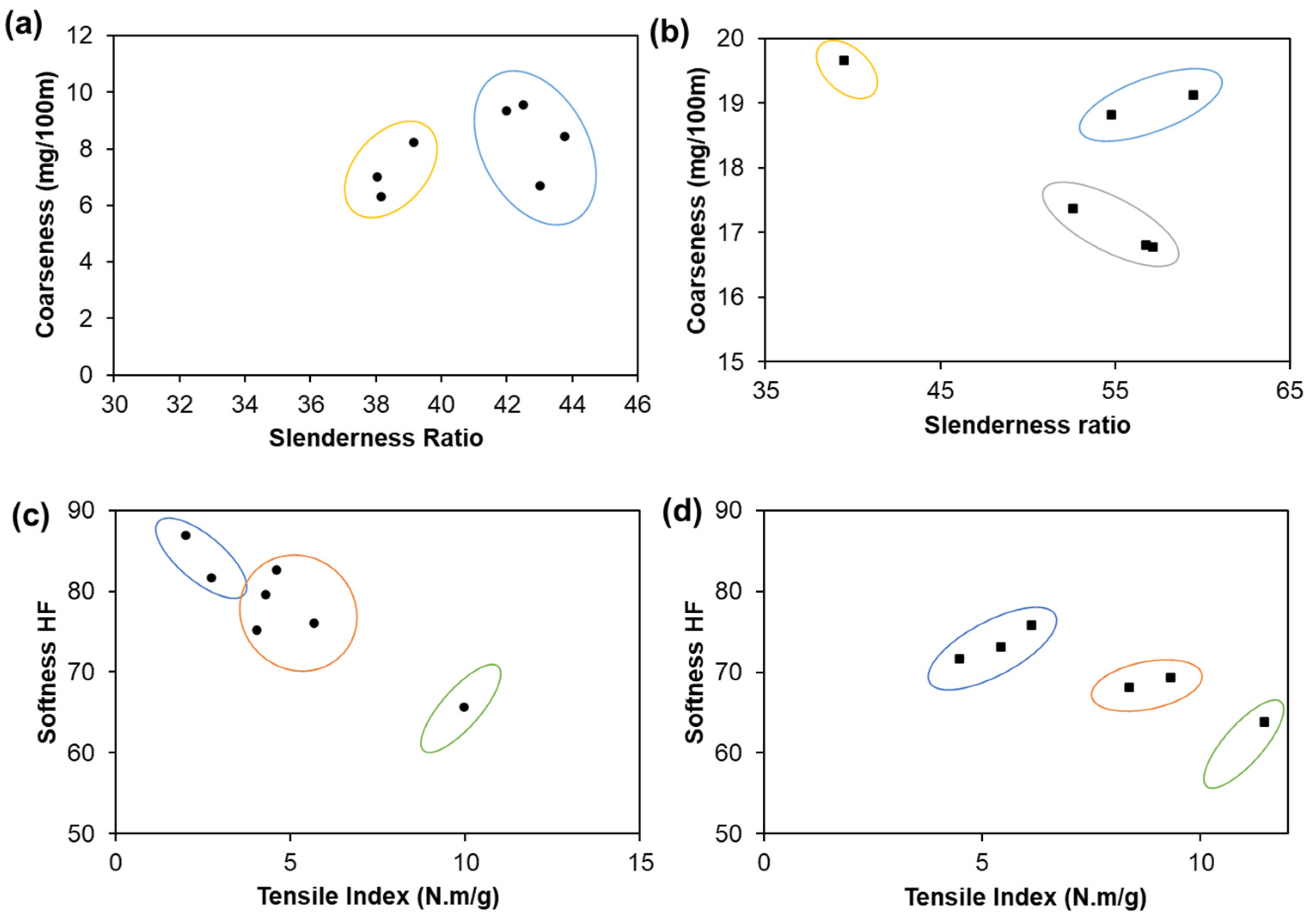

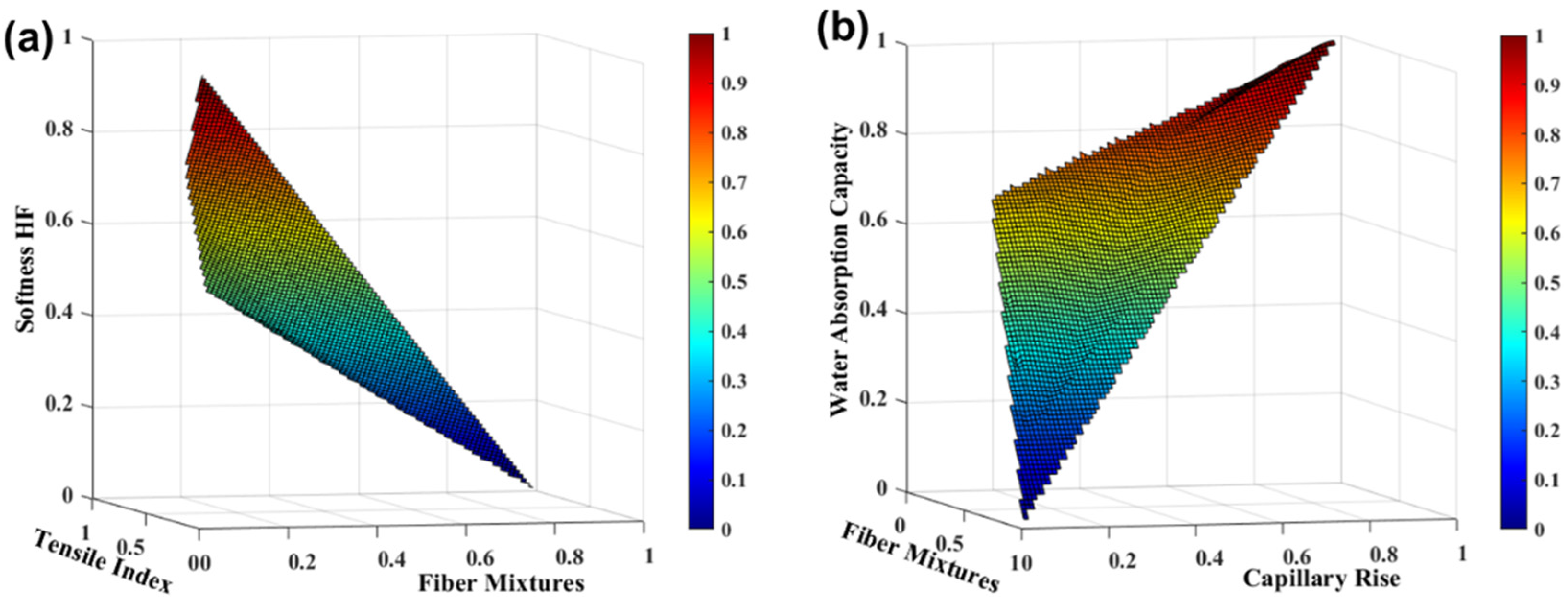
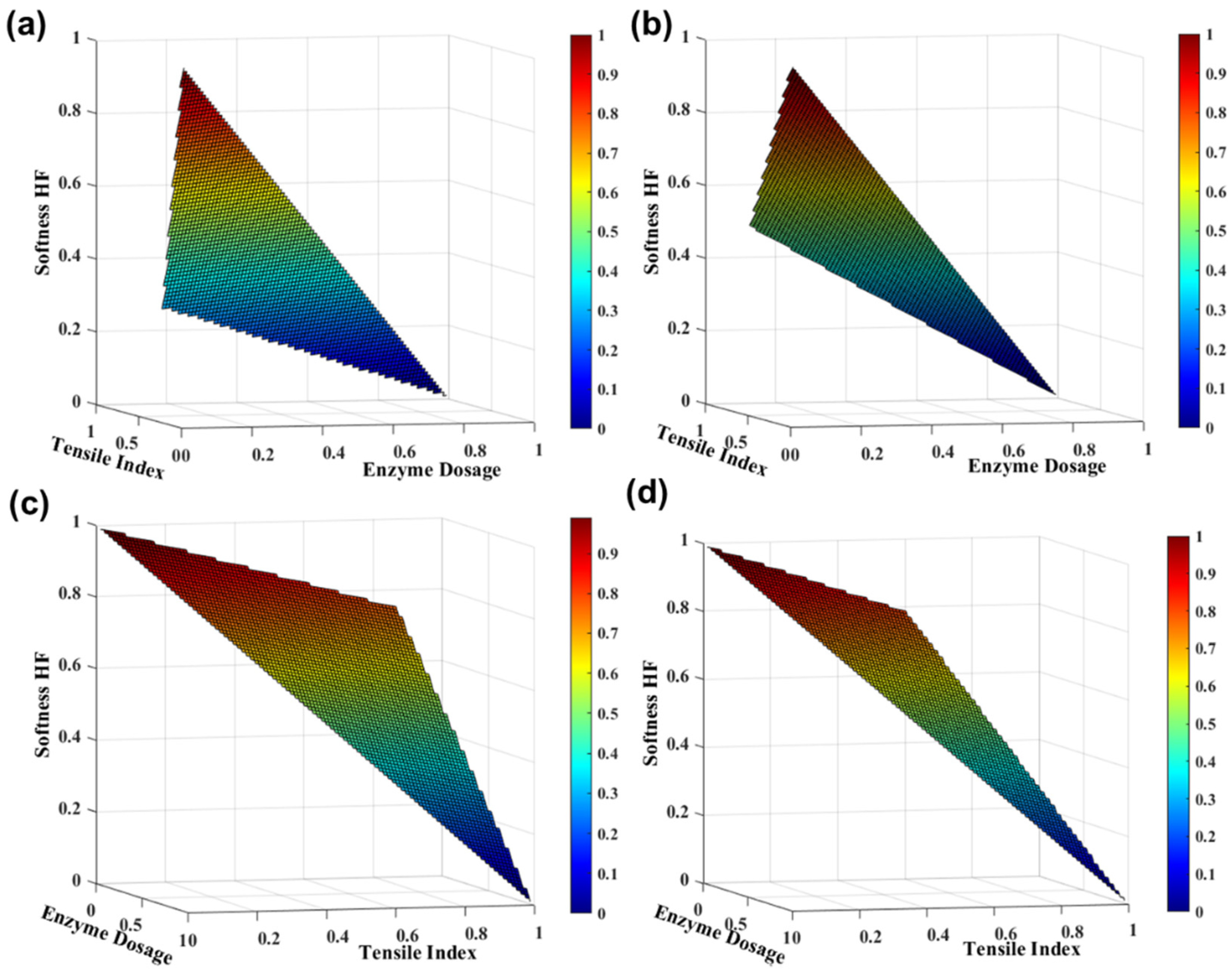


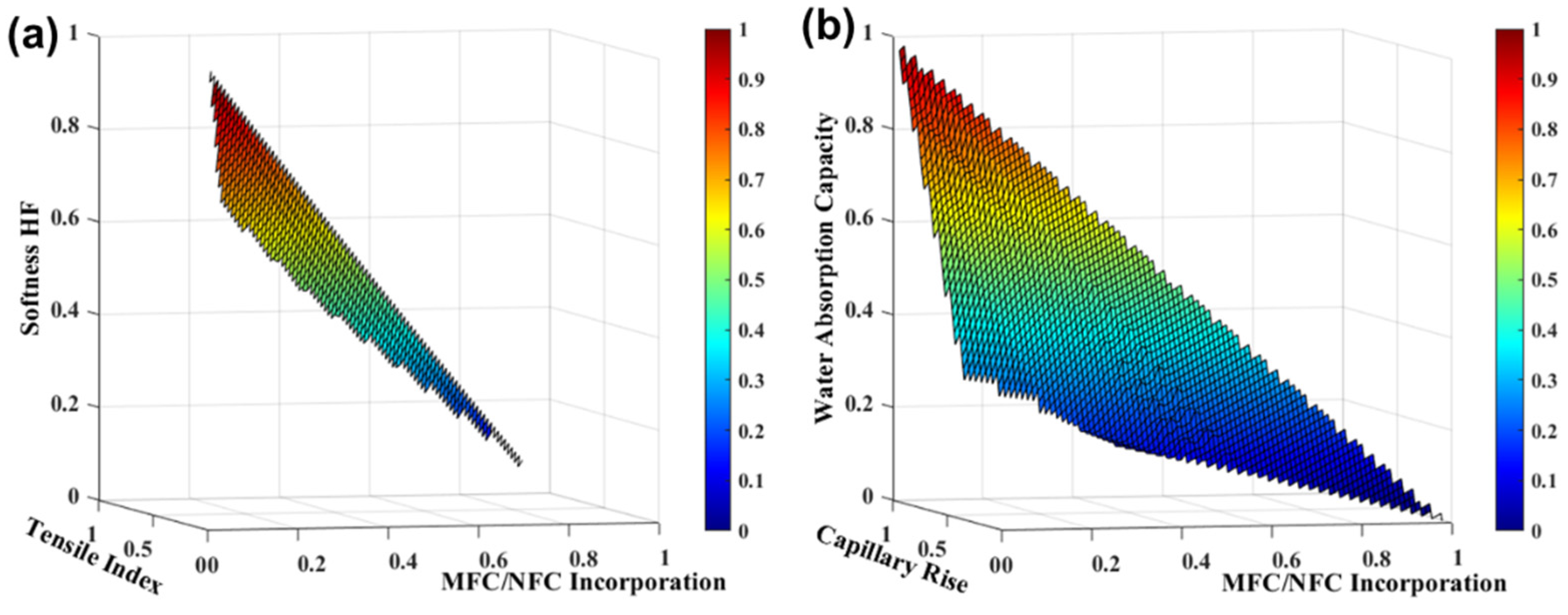
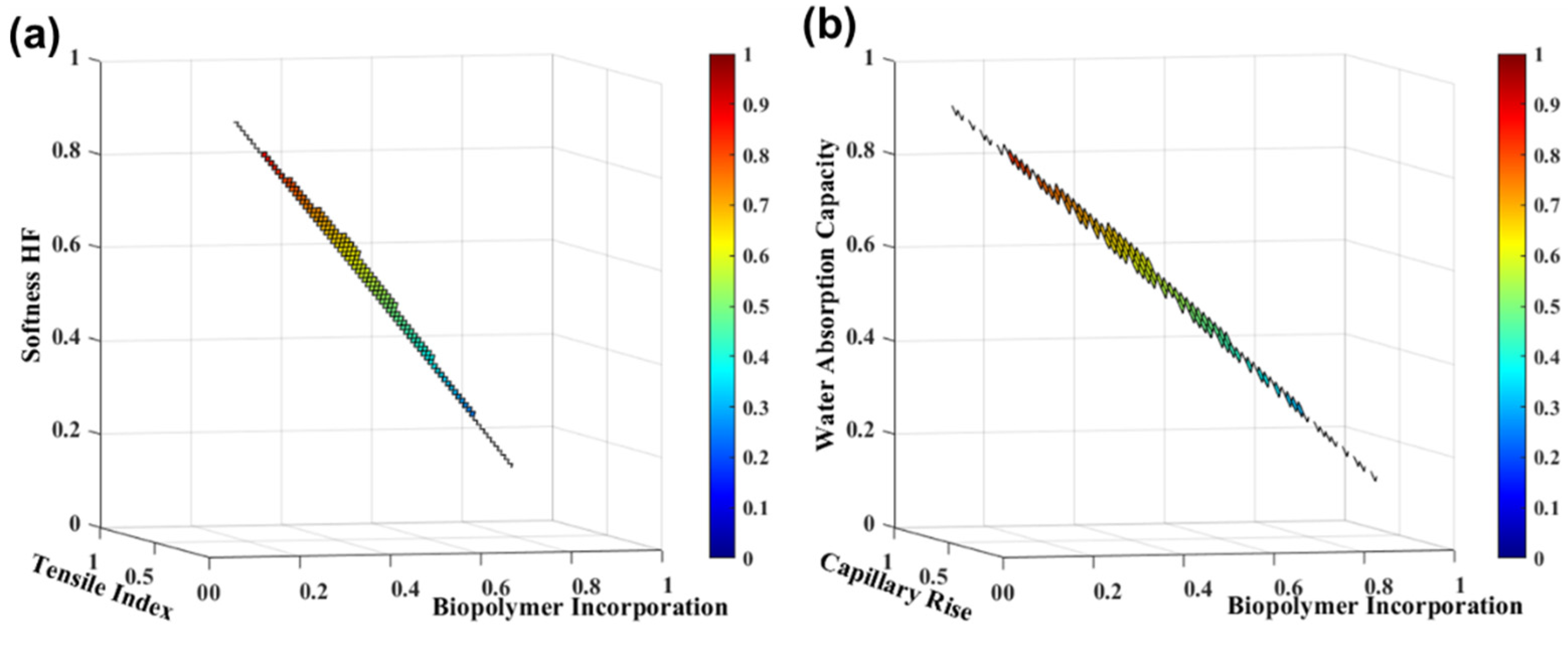
| Formulations | Hardwoods | Softwoods | Fiber Modification Process | Additives Incorporation |
|---|---|---|---|---|
| 1 | 80% Eucalyptus kraft pulp + 20% Eucalyptus sulfite pulp | - | Both with enzymatic treatment of 10 g/ton, at 60 min | - |
| 2 | 80% Eucalyptus kraft pulp + 20% Eucalyptus sulfite pulp | - | First with enzymatic treatment of 10 g/ton, at 30 min + Second without treatment | - |
| 3 | 90% Eucalyptus kraft slush pulp | 5% softwood kraft pulp | Beating process of softwood pulp achieving 25 °SR | 5% MFC/NFC |
Publisher’s Note: MDPI stays neutral with regard to jurisdictional claims in published maps and institutional affiliations. |
© 2021 by the authors. Licensee MDPI, Basel, Switzerland. This article is an open access article distributed under the terms and conditions of the Creative Commons Attribution (CC BY) license (https://creativecommons.org/licenses/by/4.0/).
Share and Cite
Morais, F.P.; Carta, A.M.M.S.; Amaral, M.E.; Curto, J.M.R. Computational Simulation Tools to Support the Tissue Paper Furnish Management: Case Studies for the Optimization of Micro/Nano Cellulose Fibers and Polymer-Based Additives. Polymers 2021, 13, 3982. https://doi.org/10.3390/polym13223982
Morais FP, Carta AMMS, Amaral ME, Curto JMR. Computational Simulation Tools to Support the Tissue Paper Furnish Management: Case Studies for the Optimization of Micro/Nano Cellulose Fibers and Polymer-Based Additives. Polymers. 2021; 13(22):3982. https://doi.org/10.3390/polym13223982
Chicago/Turabian StyleMorais, Flávia P., Ana M. M. S. Carta, Maria E. Amaral, and Joana M. R. Curto. 2021. "Computational Simulation Tools to Support the Tissue Paper Furnish Management: Case Studies for the Optimization of Micro/Nano Cellulose Fibers and Polymer-Based Additives" Polymers 13, no. 22: 3982. https://doi.org/10.3390/polym13223982
APA StyleMorais, F. P., Carta, A. M. M. S., Amaral, M. E., & Curto, J. M. R. (2021). Computational Simulation Tools to Support the Tissue Paper Furnish Management: Case Studies for the Optimization of Micro/Nano Cellulose Fibers and Polymer-Based Additives. Polymers, 13(22), 3982. https://doi.org/10.3390/polym13223982









